Recent News
Returning shark brings slew of new dataFriday, September 07, 2012
FRIDAY, SEPT. 7: A tiger shark that was tagged in Bermuda in 2009 has turned up near the island again three years later.
Former aquarium shark enjoys life on the wild side
Friday, September 07, 2012
FRIDAY, SEPT. 7: Osbourne the aquarium shark seems to be thriving in the wild.
Video: Aquarium Shark Released Into The Wild
Monday, August 27, 2012
“Osbourne,” a 7-year-old Galapagos shark, was released into the wild in March of this year after spending the past 6 years at the Bermuda Aquarium.
Young conservationist’s career ambitions take flight
Saturday, August 25, 2012
Most Bermudians feel a justifiable familiarity with the iconic longtails that teem to the Island during the warmer months — apprentice conservationist Miguel Mejias gets to work alongside them.
Website allows the public to follow the travels of five turtles caught in local waters
Wednesday, August 15, 2012
Five unsuspecting turtles yesterday are participants in the Bermuda Tour de Turtles, a three-month race through the Island’s waters.
About
GovernanceAbout Us
Newsletter
Latest News
Gift & Bookstore
Contact
General Inquiries
info@bzs.bm
Latest News
All the latest updates and news from the Bermuda Aquarium, Museum, and Zoo, one of Bermuda's leading visitor attractions!
Owain Johnston-Barnes
Published Oct 25, 2017 at 8:00 am (Updated Oct 25, 2017 at 7:38 am)
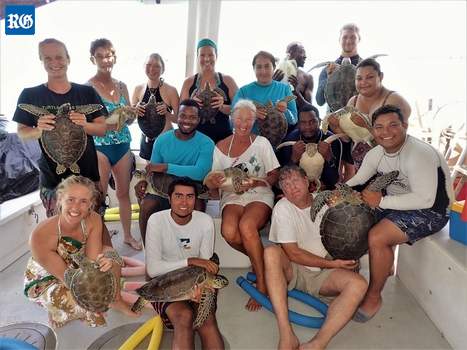
Shelling out: the Bermuda Turtle Project 2017’s
international course participants
Almost 200 turtles were plucked from the island’s waters this August as the Bermuda Turtle Project continued its conservation work.
While fewer turtles were found at offshore sites, the number of small turtles found closer to shore have risen.
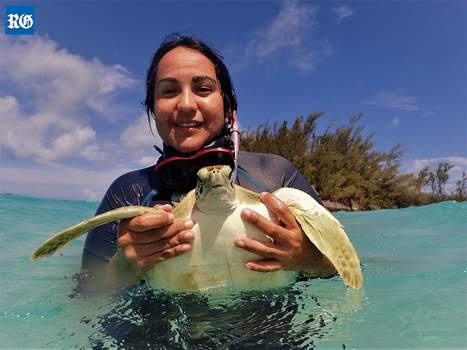
A fine specimen: Sandra Gallegos, from Mexico,
captures a healthy green turtle
A spokesperson for BTP said: “Following hatching on the nesting beach, sea turtles spend a few years out in the open ocean before moving into coastal habitats such as Bermuda.
“The increase in small turtles is not unexpected given the increase in the major nesting populations known to contribute to the green turtle aggregation in Bermuda. The organisation added that nesting populations in Costa Rica, Florida and Mexico have all grown thanks to conservation efforts.
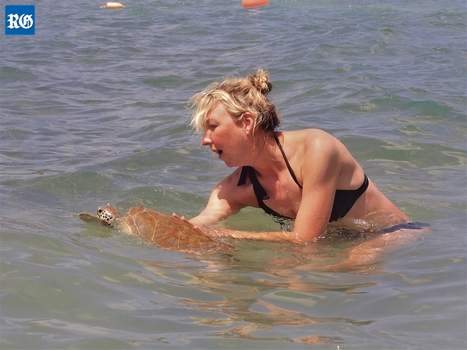
Gently does it: Abigail Alldis, a Bermuda participant,
gently releases a green turtle
BTP was first launched in 1968 to learn more about Bermuda’s turtles.
This year, volunteers and organisers visited 14 sites over a two-week period in August, catching and releasing 194 green turtles.
While fewer turtles and seagrass were found in areas like Fort St Catherine and Grotto Bay, other areas including Bailey’s Bay and Somerset Long Bay continued to be rich with turtles.
The spokesperson added: “Among the capture were 68 turtles that had been previously tagged, most in the same site as their original capture. One had a 12-year BTP history.”
The organisation said that the number of turtles in Bermuda has not changed significantly in recent years, their distribution has.
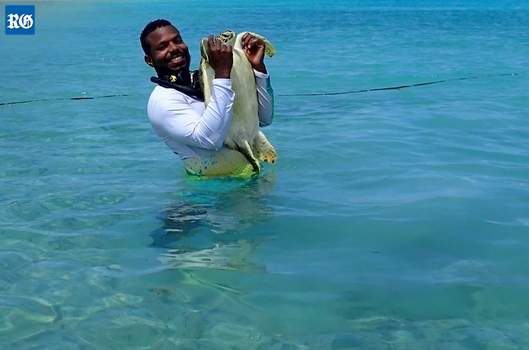
Gotcha! Damany Calder, from Jamaica,
captures a green turtle in the shallows
The spokesperson said: “With most boating activity and observations by the community taking place near shore, it makes sense that we perceive there are more turtles, but so far it just looks like they are all moving closer to shore.”
The team also performed 17 necropsies, examining dead turtles to find out what killed them.
While the results were “not out of the ordinary”, more turtles appeared to have been hit by boats than in previous years.
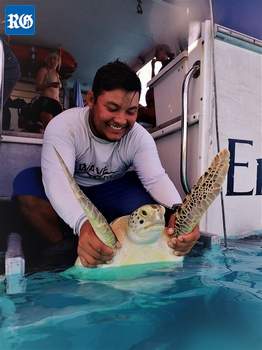
“This could well be because there were more boats out on the water in 2017 and our sea turtle hotline was promoted island- wide,” the organisation said.
“Six of the animal necropsies had propeller or blunt trauma scars indicative of boat strikes.
“Two died because of entanglement in monofilament fishing line and for the remainder we were not able to conclusively identify the cause of death. Unless the animals are fresh dead when they are examined, it is challenging to determine the cause of death.”
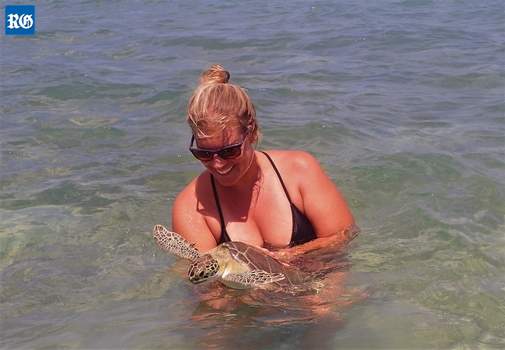
This year, the BTP was assisted by environmental officers and biologists from Jamaica, Mexico, Guatemala, Anguilla, Costa Rica and the Turks and Caicos, along with two candidates from Bermuda.
Through the course, they were able to practise a number of research methods, discuss scientific papers, attend lectures and deploy a satellite transmitter.


